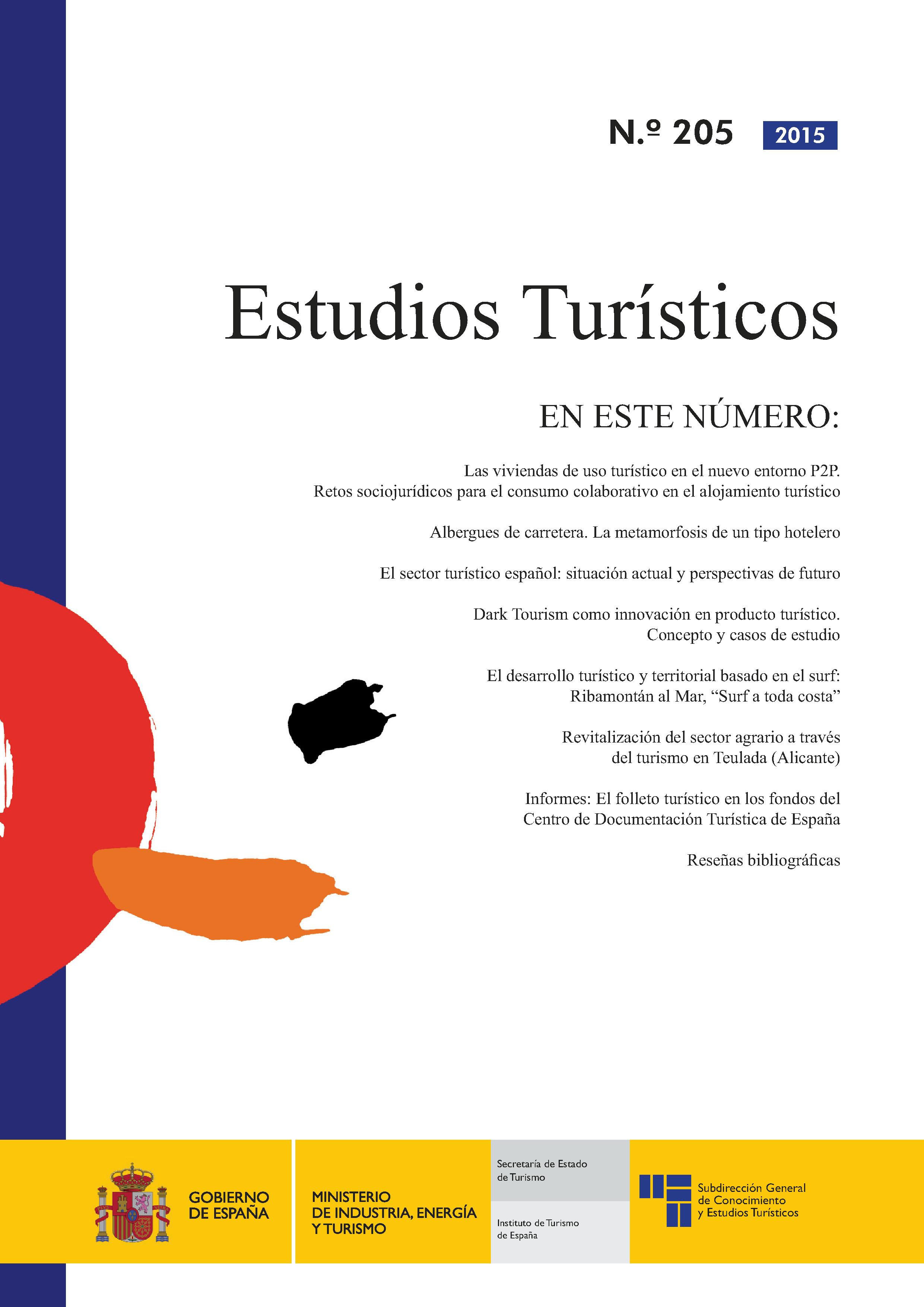Albergues de carretera: la metamorfosis de un tipo hotelero
Article Sidebar
Main Article Content
had a recurring interest from architects and tourism’s historians, due to both their value of anticipation to the Modern Movement as
well as being one of the key hotel types of the National Tourism Board (Patronato Nacional de Turismo). Nevertheless, this matter has
been regarded so far in a way that has avoided the particular scale of each one of the properties. Over forty years of the 20th century,
the roadside inns chain was a hotel structure in its own right within the national tourist accommodation chain which was born linked
to an architectural prototype. This article undertakes a critical review of the common origin of the twelve roadside inns throughout the
premises from the fi rst proposal and the fi nal project, in order to analyse its diversifi cation along the successive transformations over
time as a result of reforms, extensions or change in use. This study has taken as a starting point the unpublished documentation of various
fi les, which have been verifi ed with the in situ data gathering in each one of the roadside inns. The current outlook of a dismantled chain
and with any properties in various circumstances, some have even disappeared, requires a fi nal consideration regarding a possible reuse
of the remaining buildings.
Article Details
- María José Rodríguez Pérez, El origen de una fórmula de gestión del patrimonio: , Estudios Turísticos: No. 217-218 (2019): I Simposio Internacional "Paradores, turismo y cultura. Rumbo al centenario"
- María José Rodríguez Pérez, Javier Mosteiro, Noticia de una influencia norteamericana en el origen de la red de paradores: tornaviaje de ideas y modelos , Estudios Turísticos: No. 224 (2022): II Simposio Internacional "Paradores, turismo y cultura. Rumbo al centenario"
- María José Rodríguez Pérez, La política gestora de la red de alojamientos turísticos de propiedad del Estado (1951-1962) , Estudios Turísticos: No. 223 (2022): El turismo en España, 1951-1962
- María José Rodríguez Pérez, El turismo en los archivos estatales , Estudios Turísticos: No. 213-214 (2017): Documentación para el conocimiento del turismo
- María José Rodríguez Pérez, Patrimonio y turismo , Estudios Turísticos: No. 199 (2014): Primer trimestre de 2014
“ALBERGUES DE TURISMO” (1948): Revista Nacional de Arquitectura, nº 84, pp. 499-504.
ARNICHES MOLTÓ, C. y M. DOMÍNGUEZ ESTEBAN (1927): “La arquitectura y la vida: Refugio automovilista”. El Sol, nº 3.189, p. 4. [ARNICHES MOLTÓ, CARLOS y MARTÍN DOMÍNGUEZ ESTEBAN] (1931): “Un hotel, un albergue, un instituto”. Arquitectura, nº 148, pp. 255-278.
AZAÑA DÍAZ, M. (1939):La velada en Benicarló. Diario de la guerra de España. Buenos Aires: Losada [ed. esp. Madrid, Reino de Cordelia, 2011] “CONCURSO DE ALBERGUES AUTOMOVILISTAS” (1929). Arquitectura, nº 117, pp. 23-30.
DIÉGUEZ PATAO, S. (1997): La generación del 25. Primera arquitectura moderna en Madrid. Madrid: Cuadernos Arte Cátedra.
DÍEZ-PASTOR IRIBAS, C. (2003 a): Carlos Arniches y Martín Domínguez. Arquitectos de la Generación del 25. Madrid: Mairea.
DÍEZ-PASTOR IRIBAS, C. (2003 b): “Carlos Arniches y Martín Domínguez: arquitectura para el turismo”. (JORDÁ SUCH, C., N. PORTAS y J. A. SOSA DÍAZ-SAAVEDRA; dirs.), Valencia. Fundación DOCOMOMO Ibérico, pp.75-79.
DÍEZ-PASTOR IRIBAS, C. (2010): “Albergues de carretera (highway inns): A key step in the evolution of Spanish tourism and modernist architecture”. Journal of tourism history, vol. 2, nº 1, pp. 1-22.
DOMÍNGUEZ ESTEBAN, M. (1967): “De mi serón caminero”. Arquitectura, nº 108, pp. 47-48.
FERNÁNDEZ FUSTER, L. (1959): “Albergues y Paradores”. Temas españoles, nº 309, pp. 3-27.
FERNÁNDEZ FUSTER, L. (1991): Historia general del turismo de masas. Madrid: Alianza Editorial. [FULLAONDO ERRAZU, J. D.] (1968): “Arniches y Domínguez: arquitectos del Racionalismo español”. Nueva Forma, nº 33, pp. 89-90.
FULLAONDO ERRAZU, J. D. (1971): “Recuerdo de Martín Domínguez”, Nueva Forma, nº 64, pp. 2-22.
GARCÍA MERCADAL, F. (1928):“Encuesta sobre la nueva arquitectura”. La Gaceta Literaria, nº 32, pp. 1-6.
GUERRERO LÓPEZ, S. (2003): “Carretera, turismo y arquitectura moderna: Los albergues de automovilistas del Patronato Nacional del Turismo (1928-1946)” (JORDÁ SUCH, C., N. PORTAS yJ. A. SOSA DÍAZ-SAAVEDRA; dirs.), Valencia. Fundación DOCOMOMO Ibérico, pp. 69-73.
MUGURUZA OTAÑO, J. M. (1948):“Los albergues y paradores de turismo”. Revista Nacional de Arquitectura, nº 84, pp. 470-471.
MUÑOZ SECA, P. (1933): El refugio. Comedia en tres actos. Madrid: Espasa-Calpe.
PEYPOCH DE PERERA, L.(1928): Memoria: construcción de albergues para automovilistas en las principales carreteras del Reino. Mecan. [Patronato Nacional de Turismo]. Archivo General de la Administración.
RABASCO POZUELO, P. (2010): “Los primeros días de Martín Domínguez en La Habana” Arquitectura y urbanismo, nº 1 (vol. XXXI), pp.56-62.
RODRÍGUEZ LÁZARO, F. J. (2004): Las primeras autopistas (1925-1936). Madrid: Colegio de Ingenieros de Caminos, Canales y Puertos.
RODRÍGUEZ PÉREZ, M. J. y A. CERESUELA PUCHE (2014): “Vanguardia y turismo en el pantano de La Peña. El albergue de carretera perdido”. Zarch,journal of interdisciplinary studies in Architecture and Urbanism, nº 3, pp. 108-121.
RODRÍGUEZ PÉREZ, M. J. y A. CERESUELA PUCHE (2015): “Albergues de carretera de Carlos Arniches y Martín Domínguez. Un patrimonio que hay que conservar” Revista ph, nº 87, pp. 20-22.
ROMERO SAMPER, M. (2003). Paradores. 75 años de tradición y vanguardia. Madrid: Paradores de Turismo de España.
SORIANO FRADE, F. (1978): Estudio sobre la red de establecimientos turísticos propiedad del Estado. Mecan. Administración Turística Española. Centro de Documentación Turística de España, Instituto de Turismo de España (CDTE).
SORIANO FRADE, F. (1985): Estudio comparativo sobre los paradores de turismo 1976-1983. Mecan. Administración Turística Española. CDTE.
VEGA-INCLÁN y FLAQUER, B. de la (1927): Turismo en España. Aportación que dedica el marqués de la Vega-Inclán, comisario regio del Turismo, a la Federación Hotelera Española. Madrid: Comisaría Regia del Turismo.
VILLAR LIJARCIO, J. J.(2007): “El albergue de Bailén. 75 años a pie de carretera”. Programa de Fiestas Conmemorativas en el CXCIX Aniversario de la Batalla de Bailén, pp. 132-141.
W. JACOBS, S.(1971): “Martín Domínguez y colaboradores”. Nueva Forma, nº 64, pp. 23-25.

